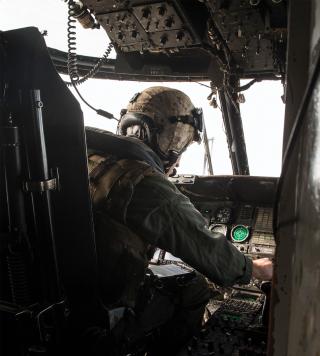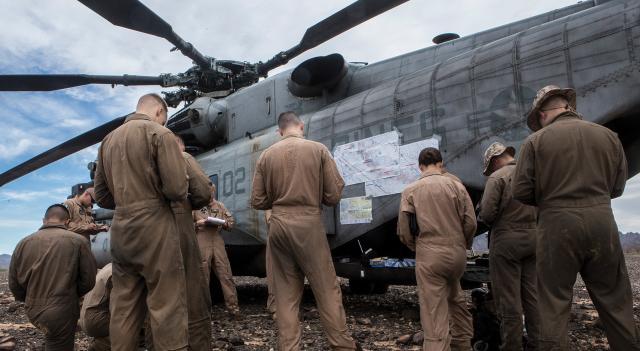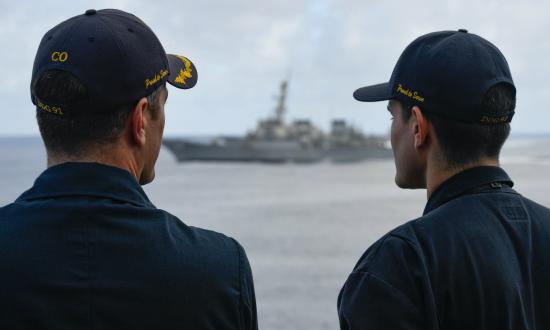On a moonless night in early 2016, two Marine Corps CH-53E Super Stallion helicopters, callsigns Pegasus 31 and 32, collided off the coast of Oahu, Hawaii. As a former Marine aviator, I was disappointed to read Lessons Learned 21-20 from the Naval Safety Center and the Marine Corps.1 Without any sense of irony, the Marine Corps and the Safety Center implicitly blame the Marines of Pegasus 31 and 32 for lacking moral courage, stating, “It takes moral courage for us to admit when—in real-time—we are not proficient in executing a training or operational mission as it was designed.”
This is not a problem of moral courage, at least not at the junior ranks. This is a problem of misaligned organizational principles.2
Operational Risk Management
In the learning process, primacy means that “what is learned first often creates a strong, almost unshakable impression.”3 All Marine Corps recruits and officer candidates have two organizational principles burned into them:
Principle One: Discipline includes immediately responding to orders. Execute the plan. Obey.
Principle Two: Marines are expected to accomplish the mission even when not provided with the tools to succeed. Improvise, adapt, and overcome. Make it happen.
The Marine Corps struggles with its safety culture because these two principles are in
tension with operational risk management (ORM), particularly in naval aviation.4 Until the Marine Corps reconciles these principles with ORM, Marines and sailors will continue to die in preventable mishaps.
Leadership and Courage
All Marines know that leadership starts at the top. The Pegasus crews were ordered by their commanding officer to execute the flight schedule. See Principle One. These Marines were part of the CH-53E community that the Marine Corps has exhausted and neglected for years. Nevertheless, they sought to complete their mission with the tools and training they had been provided. See Principle Two. According to the Judge Advocate General investigation:
A 2015 study noted that readiness within the Marine Corps’ CH-53E fleet was “appalling” due to inadequate inventory; too many aircraft in maintenance; lack of designated resources; no fleet-wide “reset” following operations Iraqi Freedom and Enduring Freedom; insufficient maintenance training, oversight, equipment, formal and on-the-job training, and technical support.5
Given the scope of this problem, it is reasonable to expect morally courageous action by general officers to avoid a seemingly inevitable fatal mishap. It is less reasonable to imply a failure of moral courage on the part of a handful of junior Marines who are unavailable to comment.
But now the Marine Corps and Safety Center hint that the fallen Marines, not the generals in charge, lacked moral courage. It seems an appropriate time to review a Marine Corps definition of courage:
Moral or physical strength to overcome danger, fear, difficulty, or anxiety. Personal acceptance of accountability and responsibility, placing conscience over competing interests regardless of consequences. Conscious, overriding decision to risk bodily harm or death to accomplish the mission or save others. The will to persevere despite uncertainty.6
With this in mind, it is difficult to think of something more courageous in peacetime than going up on a moonless night over the Pacific with teammates and aircraft from a community that the generals knew was in an “appalling” state of readiness.
The Pegasus Marines executed their orders to the best of their abilities. Remember that the deceased had just seen their skipper fired for failing to meet readiness goals.7 The idea that junior Marines would dare question their own readiness after seeing their commanding officer fired is detached from reality.
Moving Forward
Headquarters Marine Corps and Naval Safety Center should formally edit or retract Lessons Learned 21-20 and issue a public apology to the families of the Marines who died. Moral courage starts at the top. If one would not imply that a general lacked moral courage, then by the same token one should not imply that junior Marines lacked moral courage.
Marine general officers need to align their organizational principles and stop unnecessarily risking lives of Marines and sailors.
When recruits and officer candidates are trained to obey and make it happen, they must be simultaneously trained to use ORM and common sense.8 ORM must be integrated into every level of training and development. This is the comparatively easy part. Far more difficult will be effecting the cultural change required to convince generals and subordinate leaders to listen to relatively inexperienced Marines about the impossible situations in which they have been placed.9
There will always be a culture problem if Marines are left with the impression that ORM and safety are the province of staff officers with clipboards, or merely policies on a quarterdeck bulkhead, rather than how all Marines are required to train, fight, and win.10 Marine Corps Doctrinal Publication (MCDP) 1, Warfighting, MCDP 1-0, Marine Corps Operations, MCDP 1-1, Strategy, MCDP 1-3, Tactics, and Marine Corps Warfighting Publication (MCWP) 6-10, Leading Marines, never mention the concept of operational risk management. And three of these—Warfighting, Strategy, and Tactics—never mention safety.11 The absence of these concepts in these doctrinal publications signals to Marines that these ideas are not essential elements of maintaining and projecting combat power. The Marine Corps should adapt the Coast Guard’s principle of managed risk to fit operational requirements.12
The Marine Corps must incentivize the behaviors it wants to see. The fitness report form never mentions the concepts of operational risk management or safety.13 The fitness report definition of courage makes no distinction between courage in combat operations, which warrant acceptance of higher risk, and courage in noncombat operations. This absence signals to Marines that risk management and safety concepts and distinctions are not important to the service in deciding whom to retain and promote.
Most important, because the Marine Corps expects moral courage, general officers must lead with moral courage. Be candid and transparent with your Marines and the American people.14 Be not only willing, but proud to resign or be fired for what you know in your heart is the right thing. Wear the loss of your stars as a badge of honor—because it is. Lieutenant General Gregory Newbold is a good example to emulate: “A leader’s responsibility is to give voice to those who can’t—or don’t have the opportunity to—speak.”15
When organizational principles are aligned and generals lead with moral courage, the Marine Corps will lose fewer Marines and sailors in peacetime.
Two of the organizational principles that help make Marines unstoppable are paradoxically the same things that cause them to sometimes fail catastrophically at ORM. Until the Marine Corps solves this dilemma, or the nation solves it for them, the pattern will continue.
Semper paratus, and semper fidelis.
1. Konstantin Toropin, “Safety Report Urges Aviators to Show ‘Moral Courage’ and Recognize Shortcomings,” Military.com, 6 August 2021.
2. Stephen R. Covey, The 7 Habits of Highly Effective People (New York: Simon and Schuster, 1989), 32–35.
3. For an excellent summary of learning theory in aviation, see Federal Aviation Administration, Aviation Instructor’s Handbook (FAA-H-8083-9), Department of Transportation, 12 June 2020.
4. Subcommittee on Readiness Hearing: “The AAV Mishap Investigation: How to Build a Culture of Safety to Avoid Preventable Training Accidents,” House Armed Services Committee, 3 May 2021.
5. Marine Corps, Pegasus JAGMAN investigation finding of fact 196.
6. U.S. Marine Corps, USMC Fitness Report (1610), “Commandant’s Guidance.”
7. Pegasus JAGMAN investigation Finding of Fact 234.
8. Pete Blaber, The Common Sense Way: A New Way to Think About Leading and Organizing (Peter Blaber LLC, 2021), 142.
9. See, e.g., Pegasus JAGMAN finding of fact 318.
10. MarAdmin 743/20, “Publication of Marine Corps Order 5100.29C, Marine Corps Safety Management System vol. 1-5,” 10 December 2020; Commander’s Leadership Handbook, Marines.com, January 2016.
11. Safety is mentioned in Marine Corps Operations three times in two contexts: promoting maritime security as part of a larger naval strategy; and fire support coordination. In Leading Marines, safety is mentioned five times but never in an ORM context.
12. U.S. Coast Guard, Doctrine for the U.S. Coast Guard, Coast Guard Publication 1, February 2014.
13. But see in the Performance Evaluation System order the required safety and ORM comments on the fitness report at ch. 4.12.d.(2).u and x. Safety is 21st (“execution and oversight of the command’s safety policy, when applicable”) and ORM is 24th in a list of 28 topics in the catch-all category of directed comments. U.S. Marine Corps, Marine Corps Order 1610.7, Department of the Navy, 13 February 2015.
14. Compare the completely redacted endorsements of CG MarForPac and CG III MEF on the Pegasus JAGMAN investigation to the endorsements of the AAV mishap JAGMAN investigation.
15. Lt Gen Greg Newbold, USMC (Ret.), “Why Iraq Was a Mistake: A Military Insider Sounds Off Against the War and the Zealots Who Pursued It,” Time, 9 April 2006.







